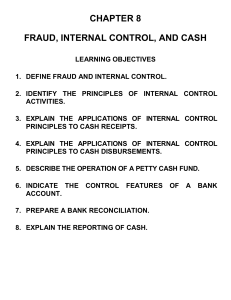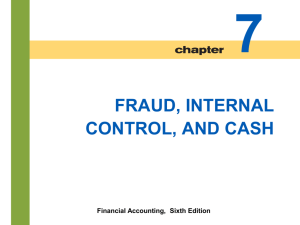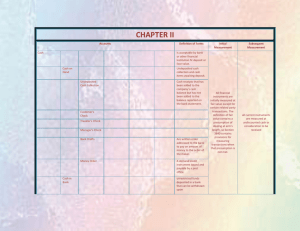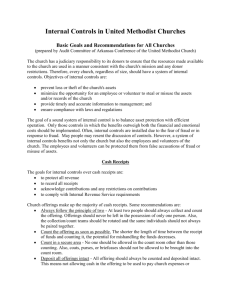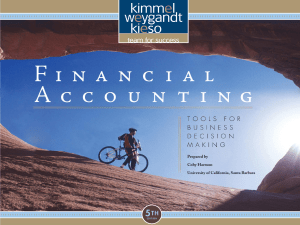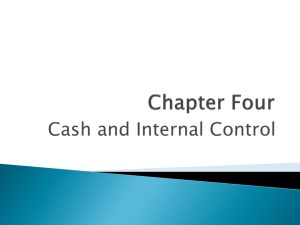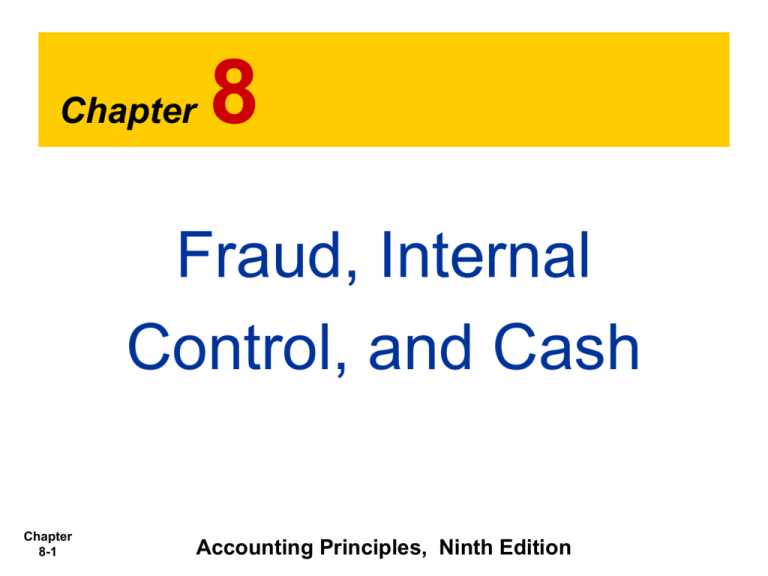
Chapter
8
Fraud, Internal
Control, and Cash
Chapter
8-1
Accounting Principles, Ninth Edition
Fraud, Internal Control, and Cash
Fraud and
Internal Control
Fraud
The SarbanesOxley Act
Internal control
Principles of
internal control
Limitations
Chapter
8-2
Cash Controls
Control
Features: Use of
a Bank
Reporting Cash
Cash receipts
controls
Making deposits
Cash equivalents
Writing checks
Restricted cash
Cash
disbursements
controls
Bank statements
Compensating
balances
Reconciling the
bank account
Electronic funds
transfer (EFT)
system
Fraud and Internal Control
Fraud
Dishonest act by an employee that results in personal
benefit to the employee at a cost to the employer.
Illustration 8-1
Why does
fraud occur?
Chapter
8-3
SO 1 Define fraud and internal control.
Chapter
8-4
Fraud and Internal Control
The Sarbanes-Oxley Act
Companies must
develop principles of control over financial
reporting.
continually verify that controls are working.
Independent auditors must attest to the adequacy
of internal control.
SOX created the Public Company Accounting
Oversight Board (PCAOB).
Chapter
8-5
SO 1 Define fraud and internal control.
Fraud and Internal Control
Internal Control
Methods and measures adopted to:
1. Safeguard assets.
2. Enhance accuracy and reliability of accounting
records.
3. Increase efficiency of operations, and
4. Ensure compliance with laws and regulations.
Under the Sarbanes-Oxley Act, all publicly traded U.S. corporations
are required to maintain an adequate system of internal control.
Chapter
8-6
SO 1 Define fraud and internal control.
Fraud and Internal Control
Internal Control
Internal control systems have five primary components
1. A control environment
2. Risk assessment
3. Control activities
4. Information and communication
5. Monitoring
Chapter
8-7
SO 1 Define fraud and internal control.
Fraud and Internal Control
Principles of Internal Control Activities
Measures vary with
management’s assessment of the risks faced.
size and nature of the company.
Six principles of controls activities:
Chapter
8-8
Establishment of responsibility
Segregation of duties
Documentation procedures
Physical controls
Independent internal verification
Human resource controls
SO 2 Identify the principles of internal control.
Fraud and Internal Control
Principles of Internal Control Activities
ESTABLISHMENT OF RESPONSIBILITY
Control is most effective when only one person is responsible
for a given task.
SEGREGATON OF DUTIES
Related duties, including physical custody and record
keeping, should be assigned to different individuals.
DOCUMENTATION PROCEDURES
Companies should use prenumbered documents for all
documents should be accounted for.
Chapter
8-9
SO 2 Identify the principles of internal control.
Fraud and Internal Control
Principles of Internal Control Activities
PHYSICAL CONTROLS
Chapter
8-10
Illustration 8-2
SO 2 Identify the principles of internal control.
Fraud and Internal Control
Principles of Internal Control Activities
INDEPENDENT INTERNAL
VERIFICATION
Illustration 8-3
1. Verify records
periodically or on a
surprise basis.
2. Records verified by an
employee who is
independent.
3. Discrepancies reported
to management.
Chapter
8-11
SO 2 Identify the principles of internal control.
Fraud and Internal Control
Principles of Internal Control Activities
HUMAN RESOURCE CONTROLS
1.
Bond employees.
2. Rotate employees’ duties and
require vacations.
3. Conduct background checks.
Chapter
8-12
SO 2 Identify the principles of internal control.
Fraud and Internal Control
Limitations of Internal Control
Costs should not exceed benefit.
Human element.
Size of the business.
Chapter
8-13
SO 2 Identify the principles of internal control.
Cash Controls
Cash Receipts Controls
Establishment of
Responsibility
Only designated
personnel are
authorized to handle
cash receipts
(cashiers)
Documentation
Procedures
Use remittance
advice (mail
receipts), cash
register tapes, and
deposit slips
Independent Internal
Verification
Supervisors count cash
receipts daily;
treasurer compares
total receipts to bank
deposits daily
Segregation of Duties
Different individuals
receive cash, record
cash receipts, and hold
the cash
Physical,
Mechanical, and
Electronic Controls
Human Resource
Controls
Illustration 8-4
Chapter
8-14
Store cash in safes
and bank vaults; limit
access to storage
areas; use cash
registers
Bond personnel who
handle cash; require
employees to take
vacations; deposit all
cash in bank daily
SO 3 Explain the applications of internal control principles to cash receipts.
Cash Controls
Cash consists of coins, currency, checks, money
orders, and money on hand or on deposit in a bank.
Cash receipts come from:
cash sales
collections on account from customers
receipt of interest, rent, and dividends
investments by owners
bank loans
proceeds from the sale of noncurrent assets
Chapter
8-15
SO 3 Explain the applications of internal control principles to cash receipts.
Over-theCounter
Receipts
Illustration 8-4
Chapter
8-16
SO 3 Explain the applications of internal control principles to cash receipts.
Mail Receipts
Control Procedures:
Mail receipts should be opened by two people, a list
prepared, and each check endorsed.
Copy of the list, along with the checks and
remittance advices, sent to cashier’s department.
Cashier adds the checks to the over-the-counter
receipts and prepares a daily cash summary and
makes the daily bank deposit.
Copy of list sent to treasurer’s office for
comparison with total shown on daily cash summary.
Chapter
8-17
SO 3 Explain the applications of internal control principles to cash receipts.
Cash Controls
Cash Disbursements Controls
Generally, internal control over cash disbursements
is more effective when companies pay by check,
rather than by cash.
Applications:
Voucher system
Petty cash fund
Chapter
8-18
SO 4 Explain the applications of internal
control principles to cash disbursements.
Cash Controls
Cash Disbursements Controls
Establishment of
Responsibility
Only designated
personnel are
authorized to sign
checks (treasurer) and
approve vendors
Segregation of Duties
Different individuals
approve and make
payments; check
signers do not record
disbursements
Chapter
8-19
Documentation
Procedures
Use prenumbered
checks; checks must
have an approved
invoice; require
employees to use
corporate credit cards
for reimbursable
expenses
Physical Controls
Store blank checks in
safes, with limited
access; print check
amounts by machine in
indelible ink
Illustration 8-6
Independent Internal
Verification
Compare checks to
invoices; reconcile bank
statement monthly
Human Resource
Controls
Bond personnel
who handle cash;
require employees
to take vacations;
conduct background
checks
Cash Controls
Cash Disbursements Controls
Voucher System
Network of approvals, by authorized
individuals, to ensure all disbursements by
check are proper.
A voucher is an authorization form prepared
for each expenditure.
Chapter
8-20
SO 4 Explain the applications of internal
control principles to cash disbursements.
Cash Controls
Cash Disbursements Controls
Petty Cash Fund - Used to pay small amounts.
Involves:
1. establishing the fund,
2. making payments from the fund, and
3. replenishing the fund.
Chapter
8-21
SO 5 Describe the operation of a petty cash fund.
Cash Controls
Illustration: If Laird Company decides to establish a $100
fund on March 1, the journal entry is:
Mar. 1
Petty cash
Cash
Chapter
8-22
100
100
SO 5 Describe the operation of a petty cash fund.
Cash Controls
Illustration: Assume that on March 15 Laird’s petty cash
custodian requests a check for $87. The fund contains $13
cash and petty cash receipts for postage $44, freight-out $38,
and miscellaneous expenses $5. The general journal entry to
record the check is:
Mar. 15
Postage expense
44
Freight-out
38
Miscellaneous expense
Cash
Chapter
8-23
5
87
SO 5 Describe the operation of a petty cash fund.
Cash Controls
Illustration: Occasionally, the company may need to recognize
a cash shortage or overage. Assume that Laird’s petty cash
custodian has only $12 in cash in the fund plus the receipts as
listed. The request for reimbursement would, therefore, be for
$88, and Laird would make the following entry:
Mar. 15
Postage expense
44
Freight-out
38
Miscellaneous expense
5
Cash over and short
1
Cash
Chapter
8-24
88
SO 5 Describe the operation of a petty cash fund.
Control Features: Use of a Bank
Contributes to good internal control over cash.
Minimizes the amount of currency on hand.
Creates a double record of bank transactions.
Bank reconciliation.
Chapter
8-25
SO 6 Indicate the control features of a bank account.
Control Features: Use of a Bank
Making Bank Deposits
Authorized employee
should make deposit.
Front Side
Chapter
8-26
Illustration 8-8
Bank Code
Numbers
Reverse Side
SO 6 Indicate the control features of a bank account.
Control Features: Use of a Bank
Writing Checks
Illustration 8-9
Written order signed by depositor directing bank to pay
a specified sum of money to a designated recipient.
Maker
Payee
Payer
Chapter
8-27
SO 6 Indicate the control features of a bank account.
Control Features: Use of a Bank
Bank Statements
Illustration 8-10
Debit Memorandum
Bank service charge
NSF (not sufficient
funds)
Credit Memorandum
Collect notes
receivable.
Interest earned.
Chapter
8-28
SO 6 Indicate the control features of a bank account.
Control Features: Use of a Bank
Reconciling the Bank Account
Reconcile balance per books and balance per bank to
their adjusted (corrected) cash balances.
Reconciling Items:
1. Deposits in transit.
2. Outstanding checks.
3. Errors.
4. Bank memoranda.
Chapter
8-29
SO 7 Prepare a bank reconciliation.
Control Features: Use of a Bank
Reconciliation Procedures
Illustration 8-11
+ Deposit in Transit
+ Notes collected by bank
-
-
NSF (bounced) checks
-
Check printing or other
service charges
Outstanding Checks
+- Bank Errors
+- Company Errors
CORRECT BALANCE
Chapter
8-30
CORRECT BALANCE
SO 7 Prepare a bank reconciliation.
Control Features: Use of a Bank
Illustration: The bank statement for Laird Company (Illustration
8-10), shows a balance per bank of $15,907.45 on April 30, 2010.
On this date the balance of cash per books is $11,589.45. Using
the four reconciliation steps, Laird determines the following
reconciling items.
Chapter
8-31
Control Features: Use of a Bank
Illustration: a) Prepare a bank reconciliation at April 30.
Cash balance per bank statement
Add:
$15,907.45
Deposit in transit
2,201.40
Less:
Outstanding checks
Adjusted cash balance per bank
(5,904.00)
$12,204.85
Cash balance per books
$11,589.45
Add:
Error in recording check no. 443
Collection of notes + interest - fee
Less:
NSF check
Bank service charge
Adjusted cash balance per books
Chapter
8-32
Illustration 8-12
36.00
1,035.00
(425.60)
(30.00)
$12,204.85
SO 7 Prepare a bank reconciliation.
Control Features: Use of a Bank
The company records each reconciling item used to determine
the adjusted cash balance per books.
Collection of Note Receivable: Assuming interest of $50 has
not been accrued and collection fee is charged to
Miscellaneous Expense, the entry is:
Apr. 30
Cash
1,035.00
Miscellaneous expense
Chapter
8-33
15.00
Notes receivable
1,000.00
Interest revenue
50.00
SO 5 Describe the operation of a petty cash fund.
Control Features: Use of a Bank
Book Error: The cash disbursements journal shows that
check no. 443 was a payment on account to Andrea Company,
a supplier. The correcting entry is:
Apr. 30
Cash
36.00
Accounts payable
Chapter
8-34
36.00
SO 5 Describe the operation of a petty cash fund.
Control Features: Use of a Bank
NSF Check: As indicated earlier, an NSF check becomes an
account receivable to the depositor. The entry is:
Apr. 30
Accounts receivable
425.60
Cash
425.60
Bank Service Charges: Depositors debit check printing
charges (DM) and other bank service charges (SC) to
Miscellaneous Expense. The entry is:
Apr. 30
Miscellaneous
Cash
Chapter
8-35
30.00
30.00
SO 5 Describe the operation of a petty cash fund.
Control Features: Use of a Bank
Electronic Funds Transfers (EFT)
Disbursement systems that uses wire,
telephone, or computers to transfer cash
balances between locations.
EFT transfers normally result in better
internal control since no cash or checks are
handled by company employees.
Chapter
8-36
SO 7 Prepare a bank reconciliation.
Reporting Cash
Cash consists of coins, currency (paper money), checks,
money orders, and money on hand or on deposit in a bank
or similar depository.
Illustration 8-14
Cash equivalents
Restricted cash
Compensating balances
Chapter
8-37
SO 8 Explain the reporting of cash.
Copyright
“Copyright © 2009 John Wiley & Sons, Inc. All rights reserved.
Reproduction or translation of this work beyond that permitted
in Section 117 of the 1976 United States Copyright Act without
the express written permission of the copyright owner is
unlawful. Request for further information should be addressed
to the Permissions Department, John Wiley & Sons, Inc. The
purchaser may make back-up copies for his/her own use only
and not for distribution or resale. The Publisher assumes no
responsibility for errors, omissions, or damages, caused by the
use of these programs or from the use of the information
contained herein.”
Chapter
8-38

